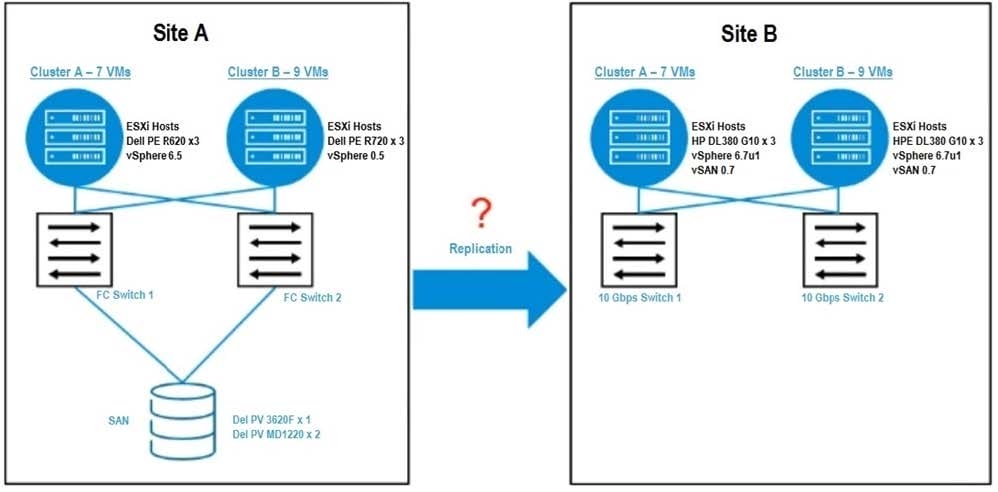Exam Details
Exam Code
:5V0-21.19Exam Name
:VMware vSAN 6.7 Specialist 2019Certification
:VMware CertificationsVendor
:VMwareTotal Questions
:100 Q&AsLast Updated
:Mar 23, 2025
VMware VMware Certifications 5V0-21.19 Questions & Answers
-
Question 31:
Refer to the exhibit.

A vSAN cluster has recently prompted an online health alarm.
What can the system administrator do to resolve the issue?
A. Disable Customer Experience Improvement Program feature.
B. Upgrade the ESXi host.
C. Suppress warning on the alarm.
D. Move VMs on affected host to other host(s).
-
Question 32:
What are two reasons why a vCenter UI can show a Noncompliant status for a VM storage object? (Choose two.)
A. The object is no longer fully compliant with the associated storage policy.
B. A storage hardware failure has caused permanent data loss for the object.
C. The VM storage compliance alarm has been triggered for that object.
D. The object is not associated with a guest VM.
E. The object is not associated with a storage policy.
-
Question 33:
What happens to a disk group during cache disk replacement?
A. goes offline
B. changes on-disk format
C. becomes degraded
D. remains online
-
Question 34:
An administrator wants to increase the capacity of a disk group cache device.
What is required to increase the cache device size?
A. Hot swap the disk group cache device.
B. Perform a storage vMotion between disk groups.
C. Put the disk group in maintenance mode and swap the cache device.
D. Recreate the disk group with a new cache device.
-
Question 35:
Where would an administrator enable deduplication and compression in a vSAN environment?
A. at the cluster level under vSAN services
B. at the object level using storage policies
C. at the host level using ESXCLI commands
D. at the disk group level
-
Question 36:
A vSAN all-flash environment with these host specifications has reported high network latency, write
latency, and faces degraded performance:
One 1Gbps (vSAN, vMotion Traffic)
One 1Gbps (Management, Fault Tolerance traffic)
Based on the specifications of each host, what is recommended to resolve the issue?
A. collapse all traffic into one 1Gbps NIC
B. collapse all traffic shared under two 10Gbps NICs
C. change stripe width to 12
D. change MTU to 9000
-
Question 37:
Which solution is used to apply upgrades to a vSAN cluster?
A. VMware vRealize Operations Manager
B. VMware Update Manager
C. VMware vRealize Automation
D. VMware Lifecycle Manager
-
Question 38:
How do vSAN fault domains relate to vSAN component placement?
A. Storage policies are inherited by vSAN fault domains.
B. vSAN objects only exist in a single vSAN fault domain.
C. The number of vSAN fault domains determines the number of components of an object.
D. Storage policies use vSAN fault domains for component placement.
-
Question 39:
A storage policy has these rules:
Site disaster tolerance: None - standard cluster
Failures To Tolerance: 2 failures - RAID-1 (Mirroring)
What is the minimum number of hosts required to comply with this storage policy?
A. 3
B. 4
C. 5
D. 6
-
Question 40:
Refer to the red question mark in the exhibit.

Which VMware solution provides automated interoperability to failover and re-protect VMs from Site A to Site B, and Site B to Site A?
A. vSphere Integrated Containers
B. NSX SD-WAN by VeloCloud
C. vRealize Operations
D. Site Recovery Manager
Related Exams:
1V0-21.20
Associate VMware Data Center Virtualization1V0-31.21
Associate VMware Cloud Management and Automation1V0-41.20
Associate VMware Network Virtualization1V0-61.21
Associate VMware Digital Workspace1V0-71.21
Associate VMware Application Modernization1V0-81.20
Associate VMware Security2V0-21.20
Professional VMware vSphere 7.x2V0-21.23
VMware vSphere 8.x Professional2V0-31.21
Professional VMware vRealize Automation 8.32V0-31.23
VMware Aria Automation 8.10 Professional
Tips on How to Prepare for the Exams
Nowadays, the certification exams become more and more important and required by more and more enterprises when applying for a job. But how to prepare for the exam effectively? How to prepare for the exam in a short time with less efforts? How to get a ideal result and how to find the most reliable resources? Here on Vcedump.com, you will find all the answers. Vcedump.com provide not only VMware exam questions, answers and explanations but also complete assistance on your exam preparation and certification application. If you are confused on your 5V0-21.19 exam preparations and VMware certification application, do not hesitate to visit our Vcedump.com to find your solutions here.